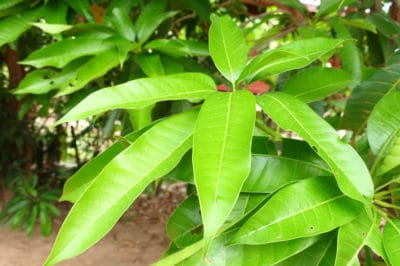Foliage Description & Habit
Mango trees quickly develop into a large, symmetrical canopy densely filled with foliage. Although the tree is classified as an evergreen, which means the tree doesn’t lose its foliage during the winter months, leaves drop periodically year-round that can create a messy appearance under and around the tree. In addition, ripe fruits held on the tree too long also have a tendency to drop on the ground and create litter.
The characteristics of mango tree leaves include:
- Oblong leaves are alternately arranged and leathery.
- Leaf size is anywhere from 6 to 16 inches long (15 to 40.6 cm).
- Mature leaves are dark green and glossy on top, and a lighter green on the underside.
- Immature leaves can range in colors of pink, reddish to amber, yellowish or pale green.
- Each leaf can live up to five years.
- Leaves have a distinct midrib that is pale with well-defined horizontal veins.
- Leaves are born in clusters.
Landscape Placement Considerations
Mango trees thrive outdoors in frost-free climates located in USDA zones 9b through 11. When considering a permanent location for the tree, consider its mature size and don’t plant where it will interfere with powerlines or structures. However, its roots are not invasive. Grow the tree where it gets good air circulation to cut down on disease problems.
The tree can be considered messy, as it seems to be constantly dropping twigs, flowers, leaves or fruit. Therefore, you might want to plant in an area where other low-growing plants hide the litter. Otherwise, be prepared to do periodic raking to clean up the debris.
If you live along the coast where winds can be a factor, plant the tree where it’s sheltered by a windbreak, especially if the area is exposed. In the coolest portion of its growing zone, plant the mango tree in the warmest part of the landscape or the south side of the house.
Mango trees grown in hot, desert locations should be planted on the north side of the house where temperatures are cooler. It also helps if the mango receives some shade during the day from another tree.
Expert Tips: The scent of the blooming flowers create allergic problems for some people. In addition, the skin of the mango fruit isn’t edible and the sap causes an allergic reaction in some people. Wear gloves when handling the fruit to prevent the sap from getting on your skin, and wash the mangoes with water after harvesting to remove the sap.
